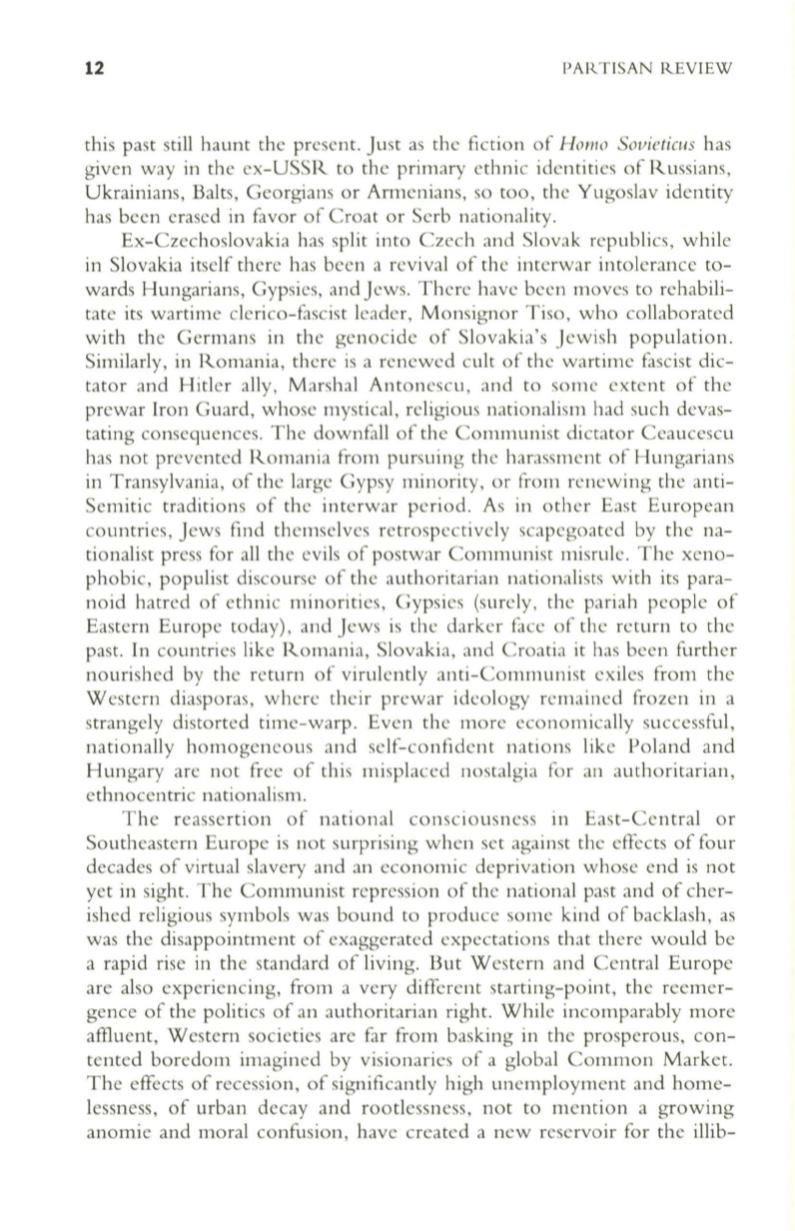
12
PARTISAN REVIEW
this past still haunt the present. Just as the fiction of
Homo SovietiCll5
has
given way in the ex-USSR to the primary ethnic identities of Russians,
Ukrainians, Baits, Georgians or Armenians, so too, the Yugoslav identity
has been erased in favor of Croat or Serb nationality.
Ex-Czechoslovakia has split into Czech and Slovak republics, while
in Slovakia itself there has been a revival of the interwar intolerance to–
wards Hungarians, Gypsies, and Jews. There have been moves to rehabili–
tate its wartime cierico-fascist leader, Monsignor Tiso, who collaborated
with the Germans in the genocide of Slovakia's Jewish population.
Similarly, in Romania, there is a renewed cult of the wartime fascist dic–
tator and Hitler ally, Marshal Antonescu, and to some extent of the
prewar Iron Guard, whose mystical, religious nationalism had such devas–
tating consequences. The downfall of the Communist dictator Ceaucescu
has not prevented Romania from pursuing the harassment of Hungarians
in Transylvania, of the large Gypsy minority, or from renewing the anti–
Semitic traditions of the interwar period. As in other East European
countries, Jews find themselves retrospectively scapegoated by the na–
tionalist press for all the evils of postwar Communist misrule. The xeno–
phobic, populist discourse of the authoritarian nationalists with its para–
noid hatred of ethnic minorities, Gypsies (surely, the pariah people of
Eastern Europe today), and Jews is the darker face of the return to the
past. In countries like Romania, Slovakia, and Croatia it has been further
nourished by the return of virulently anti-Communist exiles from the
Western diasporas, where their prewar ideology remained frozen in a
strangely distorted time-warp. Even the more economically successful,
nationally homogeneous and self-confident nations like Poland and
Hungary are not free of this misplaced nostalgia for an authoritarian,
ethnocentric nationalism.
The reassertion of national consciousness in East-Central or
Southeastern Europe is not surprising when set against the effects of four
decades of virtual slavery and an economic deprivation whose end is not
yet in sight. The Communist repression of the national past and of cher–
ished religious symbols was bound to produce some kind of backlash, as
was the disappointment of exaggerated expectations that there would be
a rapid rise in the standard of living. But Western and Central Europe
are also experiencing, from a very different starting-point, the reemer–
gence of the politics of an authoritarian right. While incomparably more
affluent, Western societies are far from basking in the prosperous, con–
tented boredom imagined by visionaries of a global Common Market.
The effects of recession, of significantly high unemployment and home–
lessness, of urban decay and rootlessness, not to mention a growing
anomie and moral confusion, have created a new reservoir for the illib-


